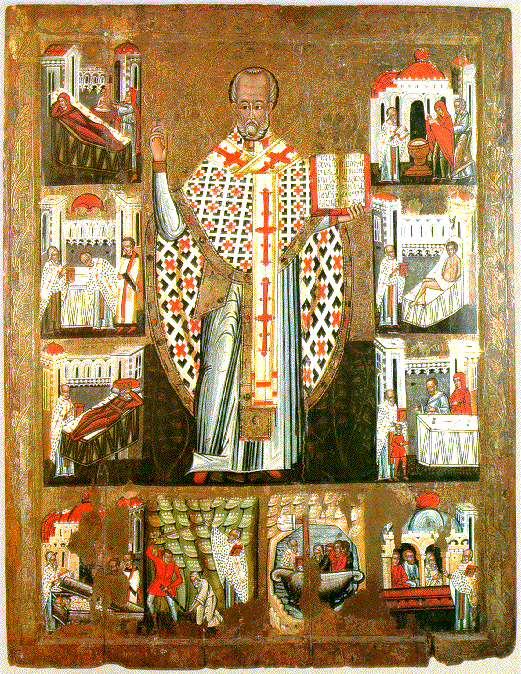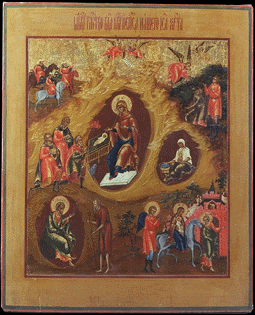In the Unites States, there are numerous "ethnic" Orthodox Churches with slightly differing ethnic traditions. There are also 2 different calendars that are used by different "jurisdictions."
A "standardized" calendar was inaugurated by Julius Caesar in 46BC. It was intended for general civil use in the Roman Empire, and came to spread throughout that empire. The First Ecumenical Synod (First Great Council), which was held in Nicaea in Asia Minor in 325, not only defended some of the most important dogmatic principles of Christianity, but also appropriated the Julian Calendar for ecclesiastical use by conjoining it to the Jewish Calendar. In that Calendar, a uniform calculation of Pascha (Easter) and the Paschalion (Easter Cycle of Feasts) was established which eventually superseded various local practices. This standard "Church Calendar" introduced a universal time-reckoning scheme, the Great Indiction, or Cycle from the Creation of the World, which remains to this day as the basis of all of the service books of the Orthodox Churches.
The Church Calendar consists of two cycles which run concurrently: the cycle of immovable Feasts (Menaion) (those associated with a particular date, like the Nativity of Christ on December 25) and the cycle of movable Feasts (those which are dependent upon the date of Pascha (Paschalion), which is variable. In the late 1700's much of Europe and the fledgling United States moved to the Gregorian Calendar, which was supposed to be astronomically more accurate than the Julian Calendar. The Orthodox Church, however, and most of the countries which were predominantly Orthodox Christian, continued to use the Julian Calendar for the reckoning of Feasts and Fasts.
One basic difference in the two calendars lies in the calculation of when leap years fall. In the Julian Calendar, every year divisible by 4 is a leap year. In the Gregorian Calendar, every year divisible by 4 is a leap year EXCEPT century years, which must be divisible by 400 to be a leap year. The difference in this calculation has caused a (currently) 13 day difference in the two calendar reckonings. For instance, December 25th on the Julian Calendar falls on January 7th on the Gregorian Calendar. In 2100, the difference will change to 14 days, as the Julian Calendar will have a leap year and the Gregorian Calendar will not. At that time, December 25th on the Julian Calendar will fall on January 8th on the Gregorian Calendar.
At the First Ecumenical Council (Nicea) in 325, the Church adopted the 'Original' Julian Calendar and ruled that Pascha would be observed on the first Sunday, after the first full moon, after the spring equinox on March 21st and independent of the Jewish Passover. This "set" the calculation of Pascha as dependent upon the lunar cycle in relation to a fixed date (March 21), and was probably done to avoid preceeding or conciding with the Jewish Passover.
The Gregorian Calendar, as implemented by the Roman Catholic and Protestant Churches, calculates Easter based on the lunar cycle in relation to a variable date (Spring Equinox). The difference in the calculation methodology permits "Western Easter" to fall during or even before Passover, which is forbidden by the Apostolic Canons and First Ecumenical Council of the undivided Church. (Pascha must always fall after Passover).
The astronomical inaccuracies inherent in the Julian Calendar (and only partially corrected by the Gregorian Calendar) led some people to promote the universal use of the Gregorian Calendar. Many believe that it is too confusing to have civil and religious calendars which differ from one another. As a result of the astronomical inaccuracies, Pope Gregory (in 1582) introduced the "Gregorian" Calendar. By the late 19th century, this calendar was being used in most Western European countries, but not, as is noted above, by the Eastern European countries which were predominantly Orthodox.
In 1923, the Ecumenical Patriarch Meletios convened a local council and proposed changing the Orthodox reckoning to the Gregorian Calendar. Several churches adopted the change, but others did not. Now, at the close of the 20th century, there is much tension between the "Old Calendarists" and the "New Calendarists."
It is not my purpose here to engage either in politics or apologetics. It is merely my purpose to explain how the Nativity of Christ is celebrated in the Orthodox Church. Consequently, it is necessary to remember that the Nativity of Christ is celebrated on December 25th on both calendars, but that December 25th on the Julian Calendar falls on January 7th on the Gregorian Calendar. Dates for the two calendars frequently are written with the Julian date first, followed by a slash and the Gregorian date thus: 25 December / 7 January. This is the notational form that will be followed here.
We prepare for the Nativity of Our Lord in the same way we prepare for the Resurrection: we fast for 40 days. This is a time when we prepare not only through fasting, but through prayer, acts of mercy, and repentance. It is a time of renewed dedication to Christ and to His Church. Beginning on November 15th, we fast from meat, meat products, wine, olive oil, and all dairy products until December 25th. On most Saturdays and Sundays of this Fast, fish is allowed. Certain feast days which fall during this fast include wine and oil. Some also include fish. These vary from year to year as to which day of the week they fall. Wednesdays and Fridays are more strict.
![]()

St. Nicholas Day: 6 / 19 December is St. Nicholas Day. Please click HERE for a definitive life of the REAL St. Nicholas! The Icon above is the "Life Icon" of St. Nicholas with scenes of special events from his life along the borders. Separate icons of the events in the life of St. Nicholas may be found HERE. St. Nicholas was the Bishop of Myra in Lycia (now Demre, Turkey) during the 4th century. He was zealously devoted to the true Orthodox faith. He attended the first Great Council of the Undivided Church and defended the faith against Arius, who was teaching falsely about the nature of Christ. He was so incensed at some of the things spoken by Arius that he punched the heretic! Of course, there was a scandal about that, but visions of Christ and the Theotokos showed the other Church Fathers the truth of the matter. Arius was defeated, and no punishment was given to St. Nicholas. He worked so many miracles, he is known as St. Nicholas, Wonderworker of Myra in Lycia. He is regarded as the patron saint of mariners. Russian Orthodox Christians became so devoted to Saint Nicholas that he is also regarded as the Patron Saint of Russia.
St. Nicholas Day, is the day Orthodox Christians give gifts to children, in remembrance of St. Nicholas and his love for the Saviour of us all.
Troparion to St. Nicholas:
"The truth of things revealed thee to thy flock as a rule of faith,
a model of meekness and teacher of abstinence;
wherefore, thou hast attained the heights through humility and riches through poverty.
O hierarch Nicholas our father,
entreat Christ God, that our souls be saved."
![]()
In the United States and other areas of North America, we celebrate the special day for St. Herman of Alaska on 12 / 25 December.
![]()
On the morning of 24 December / 6 January, we celebrate the Royal Hours of the Nativity. These are the services of the First, Third, Sixth and Ninth Hours combined into one continuous service. This is in honor of the Forefeast of the Nativity.
Troparion of the Forefeast:
"Once Mary, pregnant with a seedless
pregnancy,
was registered in Bethlehem with the elder Joseph,
as being of the seed of David.
And while they were there,
the days were accomplished that she should be
delivered,
but there was no room for them at the inn.
But the cave showed itself to be a beauteous
palace for the Queen,
and Christ is born to raise up the image that fell
of old!"
Kontakion of the Forefeast:
"Today the Virgin cometh to give birth
ineffably
to the Preeternal Word in the cave.
Dance, O world!
And having heard this, with the angels and
shepherds
glorify the pre-eternal God,
Who is to appear as a little babe."
![]()
As mentioned above, "Old Calendar" Orthodox Christians celebrate the Nativity of Christ on 25 December / 7 January. In the Slavic tradition, on the Eve of the Nativity, we go to the All-Night Vigil to celebrate the Forefeast of the Nativity of Christ.
This is a day of very strict fasting - no fish, wine or oil. After the All-Night Vigil, (which really only lasts about 2 1/2 hours in a parish church) many parishes host the Holy Supper. At this Agape Meal, we eat 12 traditional fasting dishes.
![]()

This Icon of the Nativity of Christ consists of 6 scenes. They differ as to time and place and are combined into one larger icon. Icons frequently tell a series of stories as well as depicting an individual or an event.
At the top, angels sing praises to God. At the top right, the angels announce the birth of the Christ Child to the shepherds. In the center is the Nativity of Christ. The cave is shown opened in the earth. The mountains above the cave, upon close scrutiny, are seen to have "double shelves" - these represent the earth "clapping its hands" as is mentioned in the Psalms. To the left of the cave, shepherds offer gifts to the newborn Saviour while to the right, a midwife puzzledly packs up her supplies, unused because of the miraculous Birth. In the lower left corner, St. Joseph is being tempted by the devil who is disguised as a shepherd. The wise men, following the star, are in the top left corner. They are shown riding to worship the Saviour. The lower right corner depicts the flight into Egypt. The Theotokos with the Child are with Joseph and the Holy Family is accompanied by Joseph's older son, James, the future Apostle and the first bishop of Jerusalem. In the background of this scene, there is an Egyptian temple with an idol falling down from its wall. This represents the fulfillment of Isaiah's prophecy Behold, the Lord ... shall come to Egypt: and the idols of Egypt shall be moved at his presence.
This is a 19th century Icon from central Russia. The original was painted in egg tempera with gold leaf added, and is 21" x 17".
![]()
On the morning of the Nativity, we go to Church to celebrate the Divine Liturgy for the Nativity of Christ.
Troparion of the Feast:
"Thy Nativity, O Christ our God,
hath shone forth the light of reason upon the
world;
for therein those who worship the stars
have been taught by a star to worship Thee,
the Son of righteousness,
and to know Thee, the Dayspring from on high.
O Lord, glory be to Thee!"
Kontakion of the Feast:
"Today the Virgin giveth birth unto the
Transcendent One,
and the earth doth offer a cave to Him Who is
unapproachable.
Angels and shepherds give glory,
and the magi journey with the star.
For unto us a Child is born, the Pre-eternal God!"
After the Divine Liturgy, the fast is over and we may feast on whatever foods we want! There is no fasting for the next week in celebration of the Nativity of Our Lord and Saviour Jesus Christ.
We greet one another with the salutation, "Christ is Born!" To which we respond, "Glorify Him!"
This salutation, in several languages, may be found by clicking HERE
May the Light of the Star, which showed the way to the newborn Saviour, illumine your life!
Added 11/99 revised 6/2000 Copyright ©
1999, 2000 Elizabeth W. Riggs
Broken Links? Please let me know!
e-mail: ewriggs@mindspring.com